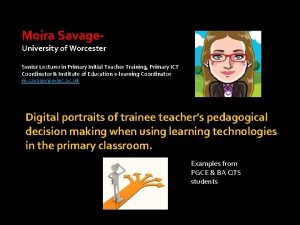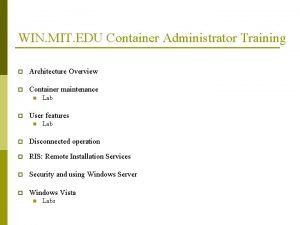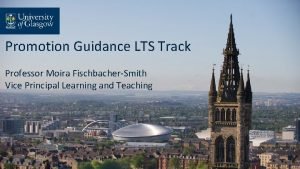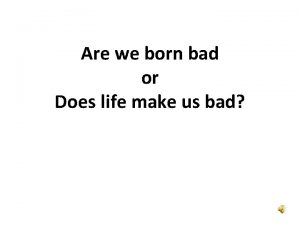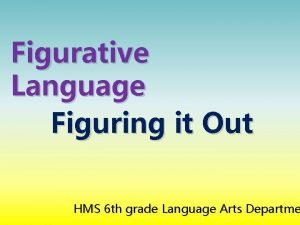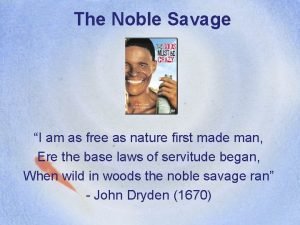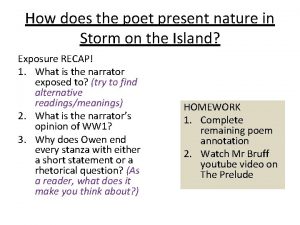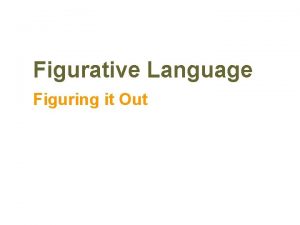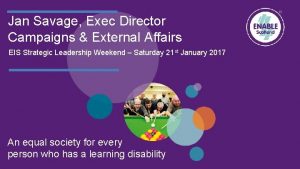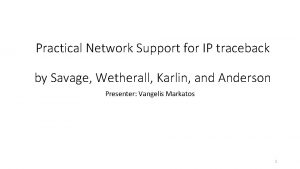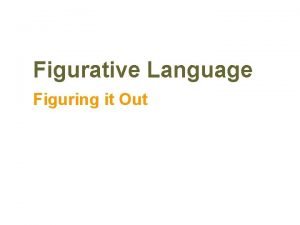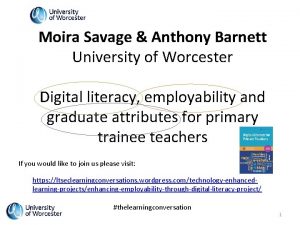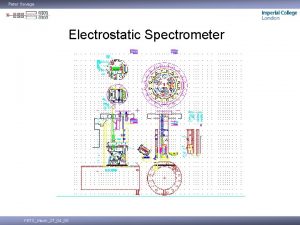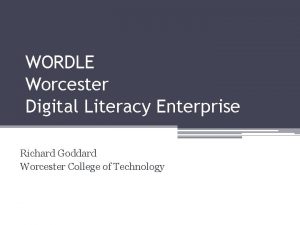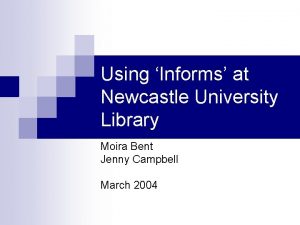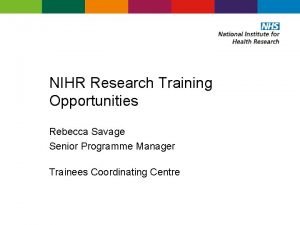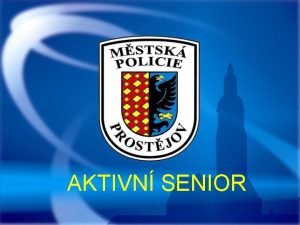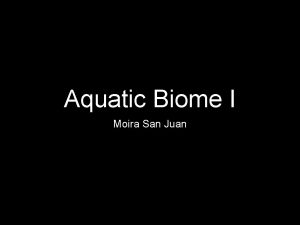Moira Savage University of Worcester Senior Lecturer in

































- Slides: 33

Moira Savage- University of Worcester Senior Lecturer in Primary Initial Teacher Training, Primary ICT Coordinator & Institute of Education e-learning Coordinator m. savage@worc. ac. uk Digital portraits of trainee teacher’s pedagogical decision making when using learning technologies in the primary classroom. Examples from PGCE & BA QTS students

Past- paper based portfolio Historically a paper-based competency type portfolio was used to assess students against QTS standards for ICT BUT… -inability to include digital assets problematic; - competency based systems in isolation run the risk of obscuring the pedagogical decision making made by trainees ‘in practice’. Present- eportfolio / blogging Eportfolio: Individual and collaborative items Self, peer & tutor assessed Liu et al suggest that ‘learning should be evaluated according to the revelation of a learner’s inner knowledge structures rather than measuring behavioural performance’ (Liu et al 2001).

To develop the capabilities of trainee teachers to create, publish and communicate in multiple digital mediums. To disseminate good practice through web-hosted peer-review activities. To foster transformative reflection on professional use of ICT on placement by creating media rich deconstructed narrative accounts.

1 year School Experience Professional ICT pedagogy Conceptualisation of the ICT e-portfolio… inspired by ESCalate 2007 eportfolios Module Reflection Fully embedded • Practical tasks • Reflective tasks • Individual tasks • Collaborative tasks

Hyperlinked narrative – internal and external (nonlinear arrangement and exploration)

Year 1 blogging- developing confidence in their professional voice (L 4)

To develop the capabilities of trainee teachers to create, publish and communicate in multiple digital mediums. Representing and communicating meaning in today’s primary classrooms is increasingly mediated by technology. 1. Must include an example from practice of using video, audio, graphics , animation, hypertext… to communicate/represent meaning to learners 2. Reflection must be communicated in at least two mediums 3. Considered the opportunities they are providing for learners to communicate in different mediums.

enabling all trainees to extend and showcase their ICT capabilities … digital literacy…employability

To develop the capabilities of trainee teachers to create, publish and communicate in multiple digital mediums. 1. Must include an example from practice of using video, audio, graphics animation, hypertext… to communicate/represent meaning to learners e. g. trainee’s choice of classroom communication technology for whole class teaching. Audio/visual resource created for MFL (MFL) http: //release. worc. ac. uk/watch. php? r=MTCP 9041&s=Y (PE) http: //release. worc. ac. uk/watch. php? r=0 Q 64 XBG 4&s=Y Using a video http: //release. worc. ac. uk/watch. php? r=RVG 4 RU 8 Z&s=Y Using audio http: //release. worc. ac. uk/watch. php? r=QZNTFFAY&s=Y

To develop the capabilities of trainee teachers to create, publish and communicate in multiple digital mediums. 2. Reflection must be communicated in at least two mediums Audio- Sam on life as a PGCE student http: //release. worc. ac. uk/watch. php? r=NER 846 EG&s=Y Animoto http: //release. worc. ac. uk/watch. php? r=5 RBLXPN 1&s=Y

To develop the capabilities of trainee teachers to create, publish and communicate in multiple digital mediums. 3. Consider the opportunities they are providing for learners to communicate in different modes

And also the impact of the medium on the message… Avatar example (Lin Tyler http: //release. worc. ac. uk/watch. php? r=IS 9 LPTMY&s=Y Mythical Creatures - manipulating photos NC Action example Understanding of how it feels to communicate in different mediums Exploring how the medium can change the message

Has it worked? Nudging reluctant trainees to engage with new technologies to complete the e-portfolio has been a useful strategy. Likewise, the ICT pioneers have been able to showcase their capability more effectively. For example, 31 trainees (2008 cohort) were asked whether completing the two e-portfolio ICT case studies on school placement had encouraged them to be experimental in their use of technologies, either in what they use or how they used it. Only 1 trainee stated they ‘only used technologies they were already familiar with. The remaining 30 trainees stated that they had tried one or more new things; 64. 5% ‘I tried 1 or 2 new things’ and 32. 3% ‘I tried lots of new things’.

Has it worked? Created a multimodal picture of the primary classroom (textual, visual and aural) picture of the primary classroom. I feel it has led to a more compelling connection between a child’s ICT learning, the practitioner and fellow professionals, including the assessor. From a trainer perspective the opportunity to have media rich content, dynamically hyperlinked with narrative and reflective commentary has brought a greater clarity of insight and understanding into emerging professional’s practice and in turn, informed my teaching. “ICT’s use of an electronic portfolio was particularly impressive. Use of multimedia data collection of children’s learning in school not only provided examples of the impact of the students’ teaching, but also exemplified how the students’ own use of ICT software had developed…” (PGCE External Examiner 2008 -2009).

To disseminate good practice through web-hosted peer-review activities. Secure Pebble. Pad gateways (safeguarding protocols) 1. Increased access to see the work of peers… self evaluation (lurking) 2. Peer review online- impact of temporal and spatial separation on feedback

To disseminate good practice through web-hosted peer-review activities. Increased access to see the work of peers… self evaluation (lurking) A significant affordance of web-based e-portfolios has been the ease of access and asynchronicity for tutors and trainees alike. This enabled a more flexible approach to peer-to peer sharing, discussion and feedback than had been possible with existing temporal and spatial limitations Beyond the scope of the directed peer review activity many trainees mentioned that the gateway allowed them to ‘check how their work compared to others’ reducing anxiety but also, hopefully cross fertilizing ideas.

To disseminate good practice through web-hosted peer-review activities.

Add a comment feature for each page Comments or feedback can be made public or private

Comments left by other students… dialogue? ‘quick’ formative feedback from peers?

Has it worked? Feedback from 55 PGCE trainees (2009 cohort) to an online evaluation questionnaire provided some surprising insights; for example, • 96. 4% of trainees felt that completing the peer review asynchronously via the Pebble. Pad gateway had allowed them to ‘think through their comments more fully’ (40% strongly agreed and 56. 4% agreed). • 54% agreed that they were ‘more honest giving peer feedback online than face to face. • One possible explanation lies in that 76. 4% of the group agreed that by ‘carrying out the peer review activity online a useful emotional distance was created where they didn’t have to monitor the reactions of the person and possibly modify what they said’. • Also, 96. 4% agreed that carrying out the activity this way meant the ‘evidence’ had to stand on its own merit.

Receiving feedback from peers (n=55) … Q. In terms of moving your learning forward, how useful were the comments left by your peer reviewers? Q. The feedback comments enabled me to. . . very useful: not useful: NA- I chose not to read them. : 32. 7% 63. 6% 0. 0% 18 reconsider the technology I had selected for this activity: 14 reconsider how I deployed the chosen technology: 26 reconsider whether the technology was enhancing my teaching: 14 reconsider whether the technology was enhancing learning: 18 35 2 0

Will you continue to use the group gateway to view the progress of your peers? Yes, to see how others are getting on but not comment: 21. 8% 12 Yes, to see how others are getting on and comment: 29. 1% 16 Yes, to check that I am doing everything correctly: 30. 9% 17 No: 18. 2% 10

“Reviewing some one else’s work made me think about my own from a more objective position” (2009 trainee).

To foster transformative reflection on professional use of ICT on placement by creating a media rich deconstructed narrative accounts. Tutor perspective- insights into trainees developing pedagogy has led to changes in my practice

Drivers Mezirow - transformational learning theory Taylor- teaching with developmental intentions How can I best facilitate learning for trainees with diverse ‘ICT histories’ in the face of ever changing technology? Confidence Questioning Holistic perspective Pedagogy led practice

Given the same instructions and reflective prompts what did the trainees typically reflect on? Typology of reflections on the use of ICT in the primary classroom

3 stage thematic coding in Nvivo of a cohorts reflective writing (text only in first stage) �Content reflection (WHAT) �Process reflection (HOW) �Premise reflection (WHY) �I am not suggesting these are necessarily hierarchical- they all have their place … �Affective dimension (choice of language e. g. ‘I forced myself, I am terrified by …’ �Developmental stages? �Cyclical when encountering new technologies? �Spiral- less time on what/how with experience?

Content reflection Largely naming and description of the technology/tool including aspects of functionality… e. g. a digital voice recorder to capture audio Discussion of pedagogical reasoning often limited

Process reflection �Here the focus of the reflection would largely be about resources available, deployment, technical issues and implementation. �Also, Timing Working order/batteries etc. Assumed skills/techniques of learners e. g. children didn’t know to log on/save/print and it took 15 minutes of the lesson to go around…

Premise reflection Trainee teacher articulates how the technology has a pedagogical impact, for example: �Interplay between technology and learning goal, � how they perceive the technology changing/enhancing the scope of the learning experience, �Reflection on changes in their (and/or colleagues and/or learners) disposition towards technology as a result of the activity/experience �Raises questions about assumptions/systemic practices �Relates/ new insights to wider world activities

To foster transformative reflection on professional use of ICT on placement by creating a media rich deconstructed narrative accounts. Tutor perspective- insights into trainees developing pedagogy has led to changes in my practice. • Now the emphasis on the ‘why’ more directe. g. How have your choices promoted learner autonomy? • Currently exploring whether trainee reflections communicated in different mediums themselves still fit the typology…

http: //pebblepad. worc. ac. uk/webfolio. aspx? webfolioid=73608 Current PGCE ICT eportfolio

References � � � � Fox, R. , White, S. , Kidd, J. and Ritchie, G. 2008. Delving Into Teachers’ Development Through Portfolio Reflections: Case Studies of Three Teachers. International Journal for the Scholarship of Teaching and Learning. Vol. 2, No. 1. Jafari, A. and Kaufman, C. 2006 Handbook of Research on eportfolios. Information Science Reference Katic, E. 2008. Preservice teachers’ conceptions about computers: an ongoing search for transformative appropriations of modern technologies. Teachers and Teaching, Vol. 14, No. 2, pp. 157 -179. Mezirow, J. 2000 Learning as Transformation. Jossey Bass Stefani, L. , Mason, R. and Pegler, C. 2007 The Educational Potential of e. Portfolios Supporting Personal Development and Reflective Learning. Routledge Taylor, K. 2000 teaching with Developmental Intention. In Mezirow, 2000 Learning as Transformation. Jossey Bass. Young, D. and Lipczynski, K. 2007 Transferability of eportfolios in Education. ESCalate- the Higher Education Academy. Http: //escalate. ac. uk/eportfolios accessed 21/10/2007 Zhi-Feng Liu, E. , Lin, S. , Chiu, C. and Yuan, S. 2001. Web-based Peer Review: The Learner as both Adapter and Reviewer. IEEE Transactions on Education, Vol. 44 No. 3 August 2001
 Moira savage
Moira savage Lecturer's name
Lecturer's name Moira king
Moira king Mit webmoira
Mit webmoira Moira fischbacher-smith
Moira fischbacher-smith Moira hindley
Moira hindley Worcester state university notable alumni
Worcester state university notable alumni Why himalayan rivers are pernnial in nature
Why himalayan rivers are pernnial in nature Jeannie watkins
Jeannie watkins Lecturer in charge
Lecturer in charge Lecturer in charge
Lecturer in charge Pearson lecturer resources
Pearson lecturer resources Spe distinguished lecturer
Spe distinguished lecturer Cfa lecturer handbook
Cfa lecturer handbook Designation lecturer
Designation lecturer 140000/120
140000/120 Teacher good afternoon
Teacher good afternoon Lecturer asad ali
Lecturer asad ali Designation of lecturer
Designation of lecturer Lector vs lecturer
Lector vs lecturer Photography lecturer
Photography lecturer Lecturer name
Lecturer name Ravenous and savage from its long polar journey
Ravenous and savage from its long polar journey Storm on the island
Storm on the island Romancing the noble savage
Romancing the noble savage Wind dives and strafes invisibly
Wind dives and strafes invisibly Savage nomads mc
Savage nomads mc Nora savage nsf
Nora savage nsf Stefan savage
Stefan savage I'd rather take baths with a man-eating shark
I'd rather take baths with a man-eating shark Jan savage enable
Jan savage enable Savage network ip
Savage network ip St lawrence and atlantic railroad
St lawrence and atlantic railroad I'm a black ocean leaping and wide figure of speech
I'm a black ocean leaping and wide figure of speech
